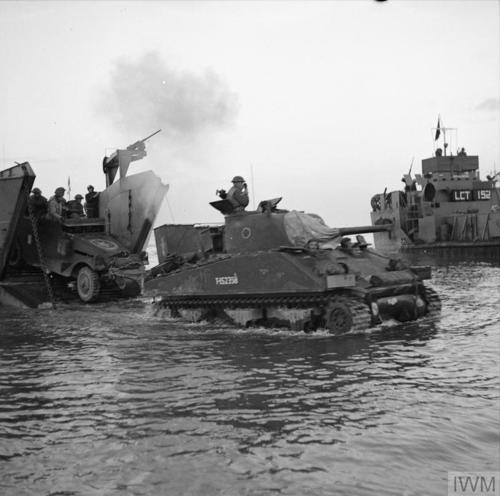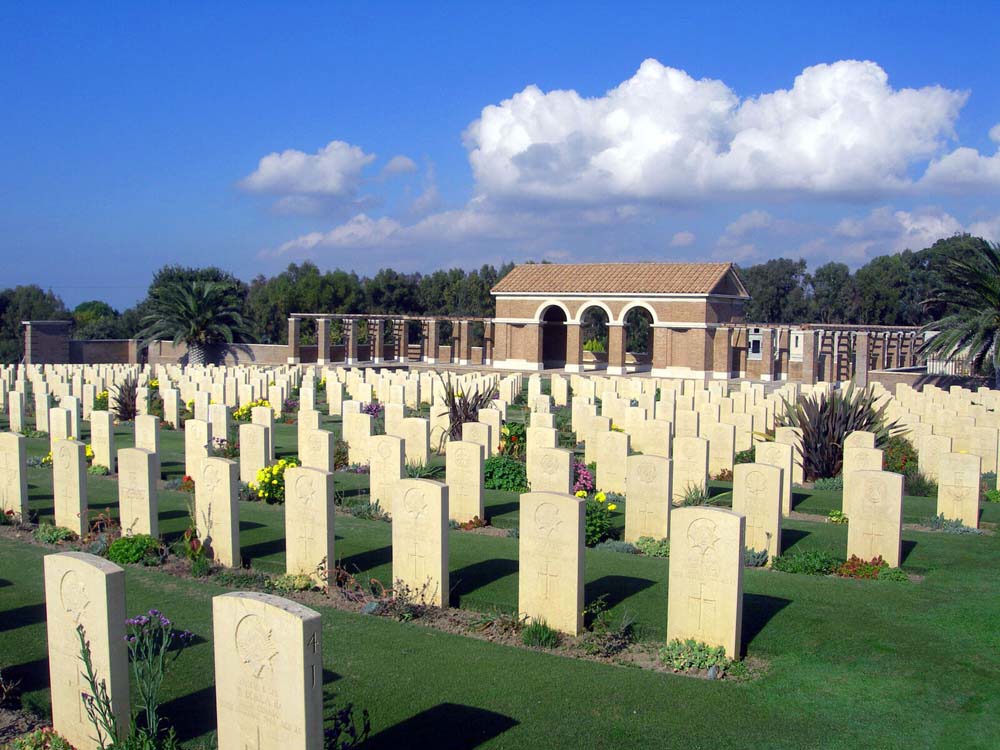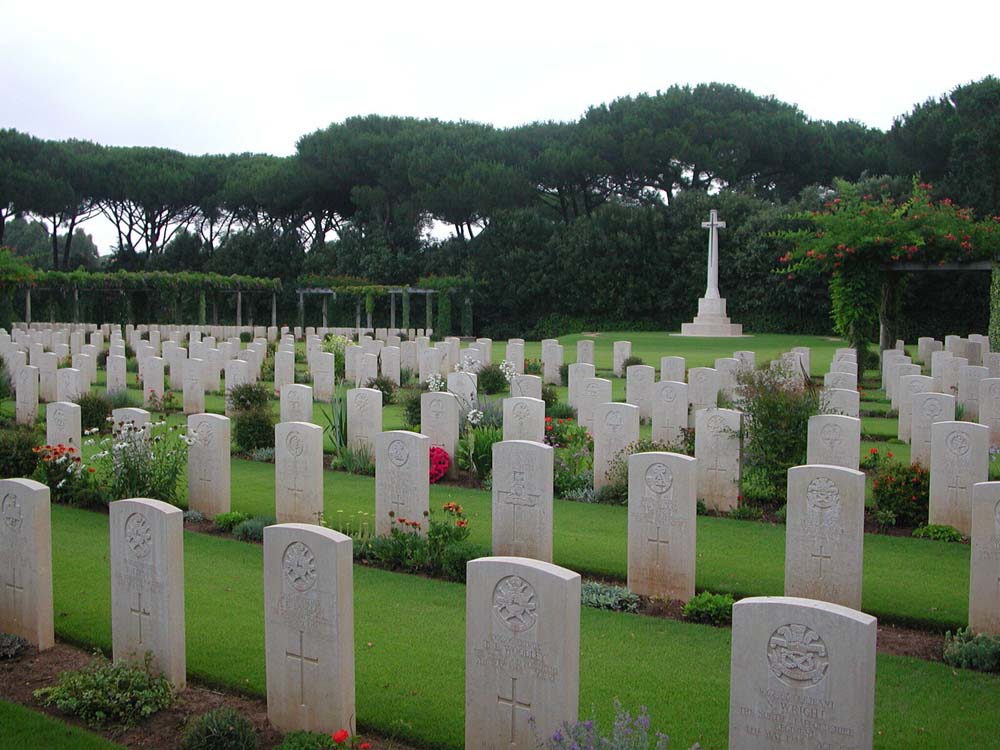22 January 2024
Legacy of Liberation: Operation Shingle & The Anzio Landings
In our next look at some of the key events of 1944, we turn to Operation Shingle and the Anzio Landings and how its fallen are commemorated.
The Anzio Landings
A pair of war cemeteries in Anzio
The peaceful port town of Anzio lies some 40 miles south of Rome. Boats bob in the harbour as the gentle blue waters of the Tyrrhenian Sea, with cafes and restaurants lining the quayside, busy with revellers and townsfolk going about their daily business.
It is said the site was blessed by the goddess Fortuna in ancient times. Certainly, the tranquillity of the spot seems to have a touch of the divine about it. But venture a few short kilometres outside the town centre you’ll find two reminders of the time Fortuna’s blessings left Anzio for a time.
Anzio War Cemetery and Beach Head War Cemetery collectively hold over 3,000 Commonwealth war graves.
Commonwealth War Graves' Italian cemeteries are some of the most beautiful in the world, expertly maintained by our teams of expert horticulturalists. These two sites are no different.
Designed by Louis de Soissons, the architecture of Anzio and Beach Head War Cemeteries draws on classical forms and stylistic flourishes resulting in two tranquil spots that offer eternal peaceful serenity for those resting there.
However, each cemetery is a reminder of the struggle undertaken by the Allies in the liberation of Italy.
Many of the men buried within were involved in the fighting of Operation Shingle: another infamous episode in the story of Italy’s liberation in World War Two.
Operation Shingle
From invasion to Cassino

Image: Map showing force dispositions around Anzio ahead of Operation Shingle (Wikimedia Commons)
Operation Shingle was an Allied amphibious operation launched on January 22, 1944.
It was conceived to break the Cassino stalemate by landing Allied forces behind enemy positions at the coastal sites of Anzio and Nettuno. The idea was the landings would draw Wehrmacht units away from Monte Cassino, forcing a breakthrough to open the way to Rome.
Amphibious operations of this size and scale are inherently risky and necessitate a preponderance of shipping, supplies and manpower to pull off.
Forcing and holding a beachhead are also important measures for success – something the Allies were reminded of after nearly being thrown back into the sea at Salerno in September 1943.
Operation Shingle was first mooted in December 1943 but put on the back burner. At the insistence of British Prime Minister Winston Churchill, who had long seen Italy as “Europe’s soft underbelly”, and wished to achive a knockout blow there, the operation was reinstated in January 1944.
US commanders still questioned whether Shingle would be a success. One of the bleaker assessments came from Major General John Lucas, who was placed in tactical command of the battle.
Lucas believed his men were not sufficiently trained and experienced for such an operation and preferred a more cautious approach to breaking out of the beaches.
The Anzio Landings
 Image: Allied ships land men and equipment in Anzio (© IWM NA 12136)
Image: Allied ships land men and equipment in Anzio (© IWM NA 12136)
On 22 January, on calm seas, the Allies launched three landings in and around Anzio:
- “Peter” beach north of the town by the British 1st Infantry Division supported by Commandos
- US Rangers attacked the port itself
- “X-Ray” beach east of Anzio led by the US 3rd Infantry
A series of Luftwaffe aircraft managed to penetrate the aerial shield to strafe the ships supporting the landing, but the Allied casualties were incredibly light on Shingle’s first day. Just 13 men were killed and 97 wounded.
By the end of the day, some 36,000 Allied servicemen and 3,200 vehicles had been deployed at Anzio.
The port itself had been evacuated ahead of the landings as the German occupiers and civilian population moved on. Most of the Wehrmacht in the region had been deployed further south to deal with a US attack at Garigliano.
With the Allies ashore and a beachhead established, surely Shingle could be a success if they grasped the initiative. A US jeep had gone ahead and scouted out a clear path to Rome.
Could Shingle achieve its objectives and deliver the breakthrough the Allies desperately craved?
The Wehrmacht counterattacks

Image: British Bren gunners scan the horizon (© IWM NA 12887)
Rather than dashing straight for the Alban Hills and pushing ahead as British General Harold Alexander desired, General Lucas decided to dig in instead.
Normal operational procedure for the Wehrmacht was when in doubt, counterattack. Certainly, the Allies were expecting Anzio to come under heavy pressure as soon as they came ashore.
Kesselring did react but rather than throwing men headlong at the beaches, he switched his reserves to the Anzio front and surrounded the beachhead. Around 41,000 German soldiers were rushed into the Anzio sector.
The US offensive to the south at Garigliano also ran out of steam, freeing up more troops for Kesselring to move to Anzio. A week after the landings, eight German divisions had the Allied positions surrounded.
US General Mark Clark reinforced Anzio with two fresh divisions, bringing the total up to 61,000 Allied personnel, but they were still stuck.
Anzio was also surrounded by low-lying marshes and sparse greenery, offering very little cover.
The Wehrmacht soon began raining artillery, including 280mm shells from a railway gun nicknamed “Anzio Annie” on the Allies dug-in on the beach. Luftwaffe dusk attacks were beginning to take a toll on the ships supporting the landings, forcing the Royal Navy to withdraw some of its larger vessels.
On 30 January, following prodding from Alexander and Clark, Lucas went on the offensive, aiming to capture Campoleone and Cisterna. The US Rangers went forward on the right flank but were caught in an ambush at Cisterna for the loss of 700 men.
On the British flank, the 1st Division went forward from Aprilia but was soon halted at Campoleone after four days of tough, costly fighting. The Sherwood Foresters bore the brunt of the casualties taking 70% losses and losing all their officers.
Further Wehrmacht attacks
Sensing the precariousness of the Allied situation, the Wehrmacht went on the attack during February 1944.
The British defensive positions around Campoleone were hit on the 7th, taking 1,400 casualties and forces to withdraw. Aprilia, which had been captured in the January 30 offensive, was wrenched back into German hands by February 10.
On 16 February, a major German counterattack, Operating Fischfang, was launched, hurling tanks and infantry at the US 45th Division, The Anzio Beachhead was struck by a force of six German divisions, but the boggy ground limited their tanks’ effectiveness.
Allied artillery blasted Fischfang to a standstill, but the Germans had driven a mile-long wedge into Allied lines.
Another German counterattack came on 29 February, but the concentrated Allied big guns saw off the attack.
General Lucas was replaced at the end of February by the dynamic Lucian Truscott, another American general, this time in command of the US 3rd Division.
Ironically, Truscott, a commander who favoured action and decisiveness, was put in charge just as the Anzio situation tipped into stalemate.
Stalemate at Anzio

Image: Men of Middlesex Regiment dig in at Anzio (© IWM)
The Allies had landed at Anzio on 22 January. For six weeks they had failed to make any progress and were now being hemmed in by a Wehrmacht army determined to hurl them back into the sea.
The trouble for the Germans was they still lacked the necessary to actively push the Allies back onto their boats. The Allies also had the benefit of controlling Anzio port, meaning it could move fresh men and supplies into the beachhead.
Gradually, German soldiers were pulled back with depleted units leaving the frontline for rest and others tasked with building fortifications and defences to keep the US and Commonwealth troops boxed in.
By now, the Anzio Beachhead resembled something out of the First World War. Between March and April 1944, Anzio descended into bitter trench warfare, complete with artillery barrages, patrols in No Man’s Land, and sniper duels.
Sickness also set in with malaria a particular hazard, spread by mosquitos buzzing around Anzio’s marshes.
Breakthrough
 Image: A Sherman tank comes ashore at Anzio (© IWM NA 11034)
Image: A Sherman tank comes ashore at Anzio (© IWM NA 11034)
In May 1944, after several months of military setbacks and bad weather, the Allies were determined to approach the Italian offensive with renewed vigour.
With Operation Diadem launched on 11 May 1944 the situation improved for the Allies. A breakthrough at Cassino drew German troops from Anzio in an attempt to shore up the Gustav line.
At Anzio, commanders drew up their own breakthrough plans. Two scenarios were proposed:
Operation Turtle – A direct assault up the Via Anziate to Aprilia, passing the Alban Hills and heading on to Rome
Operation Buffalo – A northwards thrust at Cisterna, crossing the Alban Hills to reach the route to Rome at Valmontone
Buffalo presented a longer route to Rome but, if successful, could cut of the German Tenth Army currently pulling back from the Gustav Line.
Allied deception plans also fed misinformation to Kesselring and his subordinates. Kesselring thought the Allies would simply choose the shorter Roman route at Via Anziate and so deployed his men there. He was wrong.
Instead, the Allies launched Operation Buffalo on May 23 and stormed toward Cisterna. The town’s defenders had been moved elsewhere, leaving a weak garrison, which the Allies simply swept aside.
After four months of difficult, bloody fighting, the Allies were finally out of Anzio and making for the Italian Capital.
The link-up of the US VI Corps and US 85th Division formally brought Anzio to an end on 25 May 1944. The Allies then advanced to the newly established German Cesar Line just south of Rome, achieving a breakthrough on 2 June and entering Rome on 4 June.
Casualties of Operation Shingle
The Anzio Landings were costly.
A total of 43,000 Allied casualties were sustained during the four-month battle with 7,000 killed.
The Commonwealth forces account for around half of the war dead of Anzio. These are the service personnel at rest in Anzio War Beach Head War Cemeteries.
Reflecting the multinational nature of the Italian campaign, the Commonwealth nations are well represented amongst the war graves at the Anzio cemeteries.
As well as UK personnel, the cemeteries contain burials from:
- Australia
- New Zealand
- Canada
- India
- South Africa
Stories of Anzio
Below is a small selection of stories of the fallen of the Anzio Landings in Commonwealth War Graves’ care.
Second Lieutenant Eric Fletcher Waters
 Image: Second Lieutenant Eric Fletcher Waters
Image: Second Lieutenant Eric Fletcher Waters
Second Lieutenant Eric Fletcher Waters is as famous for his military service as he is for his unknowing influence on rock music.
Eric, born in County Durham in 1914, and his wife Mary had two sons, John, who later became a taxi driver, and Roger, one of the founding members, bass player, and creative leaders of the band Pink Floyd.
Eric was a devout Christian and an ardent pacifist. He had initially been a conscientious objector but, after joining the British Communist Party, his strong anti-fascist beliefs led to him reconsidering military service.
He enlisted in the 8th Battalion, Royal Fusiliers (Cit of London Regiment), seeing active duty in Italy.
Eric was killed on 8 February during some of the toughest fighting at Anzio. His body was never recovered and so Eric is commemorated on the Cassino Memorial.
Eric’s death had a profound effect on his son Roger, who was two years old at the time. The music and lyrics Roger wrote for Pink Floyd feature numerous references to his father’s passing, especially on The Wall and The Final Cut albums and the song When the Tigers Broke Free.
The Cairncross Twins

Image: The Cairncross Twins
Roger Waters was far from the only person to suffer the traffic loss of a loved one on the battlefield at Anzio.
In the case of the Cairncross Twins, they each fought and fell on the same day during those terrible four months on the beachhead.
Thomas and John Cairncross were identical twins from Newburgh, Fife, Scotland. They joined up in October 1943, each aged 19, originally enlisting with the Black Watch, though they were later transferred to the 1st Battalion (London Scottish) Gordon Highlanders.
With their unit, the twins travelled to Italy and were part of the British force assembled for Operation Shingle.
The Gordon Highlanders went ashore in February after the initial landings, taking positions 10 miles inland around the village of Carroceto.
On 4 February, one of the twins was killed in combat (records are spotty as to whether John or Thomas died earlier).
Deeply affected by the loss of his brother, the other twin vowed vengeance and threw himself headlong into combat. He was killed that same day.
The Cairncrosses now rest eternally in the peaceful surroundings of Anzio War Cemetery.
Sergeant Maurice Rogers VC
 Image: Sergeant Maurice Rogers VC
Image: Sergeant Maurice Rogers VC
Maurice Rogers was born in 1919 in Bristol, England.
He enlisted in the British Army at a very young age, joining up as a drummer boy, aged 14. At 18, Maurice became a part of the regular army, serving with the 2nd Battalion, Wiltshire Regiment.
Maurice saw action in some of the British Army’s earliest Second World War Campaigns. He was in France in 1940 and had to be evacuated at Dunkirk.
In 1941, Maurice married Lena Stone in Bethnal Green, London, on a short period of leave. Soon after, Maurice left the UK and took part in Operation Ironclad, the assault on Madagascar, before serving in India, Iran, Syria, Palestine, and Egypt.
Maurice landed on Sicily in 1943 and in March, the 2nd Battalion reinforced the forces at Anzio.
During the night of 2-3 June 1944 Maurice and his battalion attacked high ground held by the German forces in the breakout from Anzio. They took heavy casualties there under intense fire.
Maurice continued to push up, penetrating 30 yards inside enemy lines, drawing their fire, and causing confusion. His platoon followed his example and began to charge towards the Wehrmacht.
Maurice was blown off his feet by a grenade and wounded in the leg but continued to run on towards an enemy machine-gun post, where he was shot and killed at point-blank range. His platoon went on to achieve their objective.
Maurice was posthumously awarded the Victoria Cross for most prestigious gallantry. He is buried at Anzio War Cemetery.

Introducing For Evermore: Stories of the Fallen - the exciting new way to read and share stories of the Commonwealth's war dead. Got a story to share? Upload it and preserve their memory for generations to come.
Share and read stories


